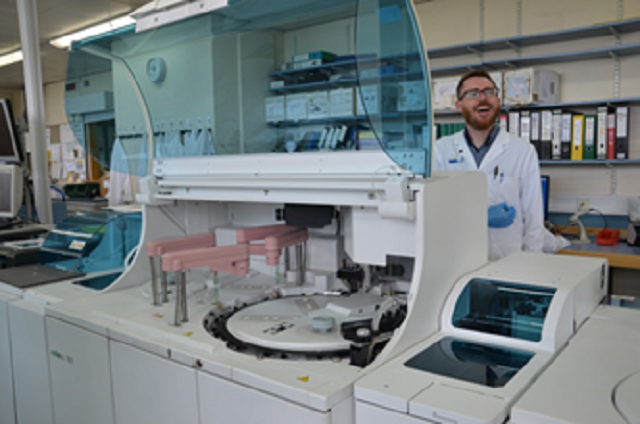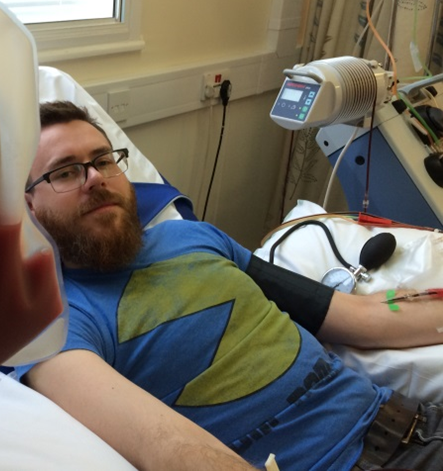Mike has a more personal connection to our cause than most: in 2004, his father was diagnosed with cancer, and sadly passed away three years later.
Now he works as a biomedical scientist at Sheffield Teaching Hospitals - and late last year, he was surprised to learn that he was a match for a patient with blood cancer in need of a transplant. Today, he's sharing his story of stem cell donation with us:
My experiences with cancer
My life was turned upside down in 2004 when my father was diagnosed with cancer.
Having just started university to study biomedical sciences, it was a really difficult first year for me as I didn’t really have anyone to turn to. He eventually lost his battle in 2007, just a week before my end-of-term exams. I postponed my studies while I attempted to reassemble the shattered pieces of my life.
My father was my idol, and to lose him when I was still so young hit me quite hard. At the time I wasn’t sure what to do, whether to complete university or to drop out and consider my options.
My girlfriend at the time was just finishing her degree, and so we both moved in with her parents who lived in Essex.
This was my first exposure to someone who had leukaemia – my girlfriend’s mother. She had chronic myeloid leukaemia (CML). I had studied cancer at university, and had taken a keen interest in it due to my father’s diagnosis.
I learned a lot about living with the symptoms of the disease during that time, and this was when I first found out about the Anthony Nolan register and the fantastic work they do. I had the contact details to join the register since 2008, but I wasn’t in a place psychologically to want to sign up.
It was when my cousin was diagnosed with leukaemia in 2011 that I decided to no longer stand by and idly do nothing – so I signed up to the Anthony Nolan register.
How I became a match
Having learned about stem cell transplants during my degree, I knew the theoretical side of how it would work to treat patients with disease such as leukaemia. But I did have my concerns about the process for collecting the stem cells, as I assumed it was all done by bone marrow extraction!
I didn’t really consider my worries, though, until I received an email in November of 2015 (four years after signing up) to say that I was a potential match. The email asked me to simply contact the team as soon as possible, which I believe I did the same day.
It was quite exciting to know that I might be able to help someone live a more fuller and hopefully longer life – I’d actually completely forgotten that I’d even signed up to the register in the first place. My girlfriend suffers with anxiety, along with a severe phobia of needles and injections, so I never really talked in detail to anybody about the donation until after it was finished, and even then it was with work colleagues.
I discussed the screening process with a colleague at work, as he had also received an email to say he was a potential match. In the end he wasn’t an ideal match, so he never got to donate.
We discussed the potential side effects of the full process, but never really had any major concerns. Working in a hospital (as a biomedical scientist) had its advantages, and in this case access to a phlebotomy service, so I was able to have my screening bloods taken and sent off on the same day!
Then on December 1st, I received another email confirming I was a suitable match asking me to again contact the Anthony Nolan office to make the arrangements for donation.

Before the stem cell donation – my G-CSF injections
My stem cell donation date was set as December 21st. This was partly from my pestering to get the donation carried out as soon as possible (which I don’t apologise for!), because I wanted to try and give my match the best Christmas present they could ask for – the gift of life.
After my chat with the consultant, I did have some apprehension about the donation process, especially when we discussed the side effects of the G-CSF stimulant they inject you with to allow your stem cells to mobilise.
I was particularly concerned about the potential chest pain, because I suffer with costochonriditis and know how uncomfortable chest pain is!
After my first injection I felt fine; with my second injection, I did notice some chest pain and tiredness, but this was all to be expected. After all, the stimulant is essentially designed to make your body think it’s fighting an infection!
The nurses that provided the injections, however, were fantastic, very friendly and eager to ensure that I fully understood the symptoms and the processes to make me feel more comfortable.
If the stimulant had failed to mobilise my stem cells, they would need me to donate bone marrow – and even though I was concerned about this, I decided to push it to the back of my head because I knew in my heart I would go through any process needed and so I didn’t linger on my worries about bone marrow donation.
The consultant was very understanding and ensured me that this only happens in a handful of cases anyway. Luckily, my stem cells did mobilise so I could go ahead with the PBSC (peripheral blood stem cell donation).
My stem cell donation day
Four days after the injections was D-Day (Donation day). I was asked to arrive early, as the stem cell donation would commence around 8.30am.
Normally Anthony Nolan would provide accommodation for the donation period, but as I only live a 30-minute walk away from my donation site, it seemed a bit pointless staying in a hotel! However, they were very keen to ensure I wasn’t out of pocket at all – even for any food I purchased during the process.
Upon arrival, the nurses collected some more blood samples to ensure I was fit and healthy enough to continue with the donation, which luckily I was!
The stem cell donation itself required my ‘body’ to essentially become part of the stem cell extraction equipment. My whole blood would be collected from one arm, passed through the machine and then returned (minus the stem cells) into the other arm.
I don’t have any issues with injections, and they felt just like having a normal blood sample taken. However, when the line was inserted for the blood going back into my arm, that was quite painful, but more because I had never had an injection in my forearm before.
After around 15 minutes, though, the pain had gone and it just felt a bit weird.

My experiences of stem cell donation
I’d brought in a book to read and my tablet to watch some movies, and I had it all planned out how I would fill the 4-5 hours needed for the collection period, but it actually went a lot faster than I could have imagined. I had a nice pleasant chat to the nurses about the procedure and what was involved from their perspective, and also to some other potential matches who had come for a medical.
About two hours into the stem cell donation, my lips began to tingle. This was a side effect of the citrate they had to put into my bloodstream to ensure my blood didn’t clot during the extraction process. The nurse gave me some calcium to drink (which actually tasted quite nice!); however, as it didn’t work as fast as she wanted, she infused me with some calcium directly into my return bloodflow.
She claimed that it might feel like I’d wet myself – which I chuckled at, but I could tell she was being serious by the face she gave me! Needless to say, I didn’t.
The excess calcium did make me feel slightly nauseous, so they allowed me to lay flat and also put a fan on me to cool me down. My collection in total took around four hours to complete; in the end, I produced over 65 units of stem cells, and they only needed 5!
Because of this, I didn’t have to return for a second day of donation at all. The most painful process of the entire donation was removing the plaster from my arm (note: hairs and plasters don’t mix!)
Why it all makes a difference
Looking back at my donation process, I do kick myself a little bit that I didn’t get on and sign up to the register sooner; but having donated, I would do it again in a heartbeat. My father always taught me to pay it forward, so I hope in donating my stem cells, I’ve done just that.
The donation process was so simple – yes, it involved being stuck a few times for the blood, but that is such a small price to pay for somebody else’s wellbeing.
I learned that my cells went to a young girl somewhere in the world and I like to think that wherever she is now, that her life has been made more enjoyable and fuller because of this donation and I can’t thank Anthony Nolan enough for giving me this opportunity to donate my stem cells.
Finally…
If you’re reading this and you’ve ever considered signing up to the Anthony Nolan register, I would recommend that you stop thinking about it, and just sign yourself up.
Even if you are selected as a match, it is still your choice to donate, and the Anthony Nolan team do everything they can to ensure any worries or fears you have are covered.
Heroes don’t always wear capes, and they don’t always have hidden powers. Most of the time they are just normal people like you and me.
Everyone in the world has been touched by cancer; and like most people, you may not even realise that you can do more than raise money and aid research. You can actually donate what you take for granted and potentially cure someone of a horrible disease.
